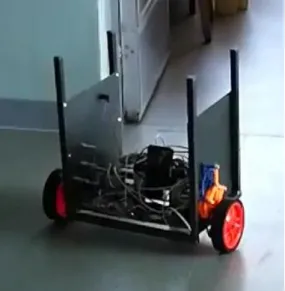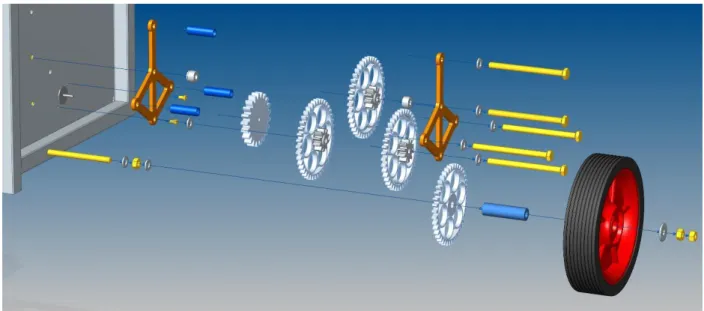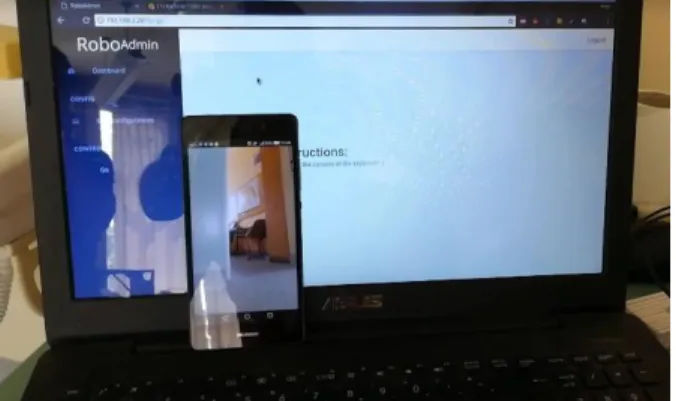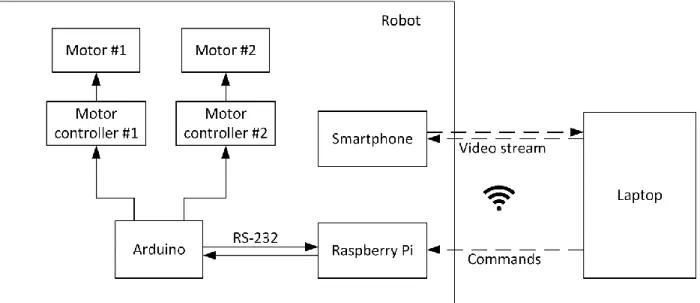www.jates.org
Technical and Educational Sciences
Engineering, Vocational and Environmental Aspects ISSN 2560-5429
Volume 8, Issue 4
doi: 10.24368/jates.v8i4.53
http://doi.org/10.24368/jates.v8i4.53
Development of telepresence technology during the teaching process at Subotica Tech
Igor Fürstnera, László Gogolákb, Peter Sarcevicc
Subotica Tech – College of Applied Sciences, Marka Oreskovica 16, 24000 Subotica, Serbia, aifurst@vts.su.ac.rs,
bgogolak@vts.su.ac.rs,csarcevic@vts.su.ac.rs
Abstract
Nowadays industrial solutions in the field of mechatronics often integrate the actuators with sensors and control units. This integration creates complex mechatronic devices. The complexity of these devices is evident, because this integration asks for communication between sensors, actuators and their control units, and communication with external control units and sensors, as well as other actuators, and often humans. To be able to prepare the students to the professional challenges they will face after finishing their studies, the teaching process at Universities and Colleges must adapt to this shift in the concept of what the industry is today, i.e. tomorrow. This research deals with the problem of developing a telepresence system at Subotica Tech as part of the project-oriented teaching process, which introduces the main aspects of modern industry, which are known as Industry 4.0. The problem is discussed by presenting a case study.
Keywords:telepresence system; industry 4.0; product development; mechatronics;
1. Introduction
Today’s industry is changing, both in conception and organization. Previously, the third industrial revolution introduced advanced electronics and information technology, which resulted in further automation of existing production processes. Nowadays, the development and establishment of global networks incorporate the machinery, warehousing systems and production facilities in the shape of Cyber-Physical-Systems. In the manufacturing environment, these Cyber-Physical Systems comprise smart machines, storage systems and production facilities capable of autonomously exchanging information, triggering actions and controlling each other independently. This facilitates fundamental improvements to the industrial processes involved in manufacturing, engineering, material usage, supply chain and life cycle management.
The Smart Factories that are already beginning to appear, employ a completely new approach to
production. Smart products are uniquely identifiable, may always be located and know their own history, current status and alternative routes to achieving their target state (Kagermann, Wahlster, and Helbig, 2013). This business approach is named Industry 4.0, which is a term publicly known from 2011, and includes six design principles (Hermann, Pentek, and Otto, 2015):
Interoperability,
Virtualization,
Decentralization,
Real-Time Capability,
Service Orientation,
Modularity.
Interoperability means that all Cyber-Physical-Systems can communicate with each other and are connected over to Internet of Things and Internet of Services in the context of SmartFactory (2016). Virtualization means that a virtual copy of the physical world allows the monitoring of the processes (Gorecky, Schmitt, and Loskyll,2014). Decentralization as a demand, which arises due to increasing difficulties to control systems centrally, makes it necessary to keep track of the whole system at any time. To be able to keep track of the whole system at any time, real-time capability is required. To be able to answer to specific customer requirements, service orientation is needed as well (Schlick, Stephan,Loskyll, and Lappe, 2014). Finally, modularity as an approach enables flexibility regarding to the adaptation of changing requirements by providing functional independency of individual modules (Pine, 1993).
Modern mechatronic devices are gaining more ground in most diverse areas. Large number of devices contain more and more mechatronic elements (Fürstner, and Gogolak, 2015). These devices also have multiple sensors and actuators.Therefore, the teaching process at Universities and Colleges has to adapt to this shift in the concept of what the industry is today, i.e. tomorrow, and to prepare the students to the professional challenges they will face after finishing their studies (Solis, Nakadate, Yoshimura,Hama, and Takanishi, 2009). Mechatronic systems are playing an increasingly important role nowadays. Therefore, the understanding of the design and control of such systems is a necessity for the future engineers. The teaching process faces a problem, which arises from the fact that this process requires multidisciplinary approach.
Nevertheless, students are willing to do research work for solving practical problems when these are related to an interesting competitive contest (Odry, Harmati, Kiraly, and Odry, 2015).Winning one or two awards in a contest gives students a sense of accomplishment and gives to the institution a sense of pride and visibility. This is an important factor for technology- oriented university students, who often have low learning achievements in traditional theory- based lecture courses (Su, Cai, Lee, and Chen, 2016).
Educational mechatronics is an innovative way for increasing the attractiveness of science education and scientific areas in the view of young people. As a multidisciplinary field, it promotes the development of systems thinking and problem solving. Also, teamwork, creativity and entrepreneurial skills are required for the design, programming and innovative exploitation of mechatronics. Consequently, it is regarded as very beneficial if engineering schools and university program studies include the teaching of both theoretical and practical knowledge on mechatronics.
At Subotica Tech, this new business approach is taken into consideration by introducing multidisciplinary projects, often in cooperation with companies, into the curricula, i.e. into specific courses, namely into the course of Design of Mechatronic Devices and Project. By doing this, students from Mechanical Engineering, Electrical Engineering, Informatics, and Mechatronics can work in teams on a rather complex problems, producing results, which would be difficult to achieve if working alone.
One form of a modern mechatronic device is a telepresence system. These systems are an emerging topic, mostly in the fields of unmanned vehicle systems, particularly in remote communication, and/or field inspection. Telepresence, as a mechatronic device, covers a great variety of technologies and human studies. Therefore, it is difficult to systemize, implement, and examine it and is usually analyzed in different perspectives, such as tele-operated construction systems, telepresence systems of unmanned vehicle systems, human-machine interfaces, visual aid and perception, and user operation (Wen, Yang, Tsai, and Kang, 2018).
Regarding the construction of the system, the research focuses mainly on the structure of the system, which incorporates a series of sensors, actuators and control mechanisms (Higgins, and Slaughter, 1993). The research of the unmanned vehicle systems has brought much attention in the recent years, because of their high mobility and low cost (Dadhich, Bodin, & Andersson, 2016; Ellenberg, Kontsos, Moon, &Bartoli, 2016; Zakeri, Nejad, & Fahimifar, 2016).
The research regarding human-machine interfacesfound that theloss of situational awareness, inaccurate attitude judgment, and failureto detect obstacles are common occurrences. The operator is an integralpart of the control loop and because he/she depends on video for perception,direct interfaces typically demand low-delay, and therefore high- bandwidthcommunications (McGovern, 1991).
In the case of remote systems, visual feedback can often be limited by onboard camera restrictions. Also, most of the existing systems currently rely on 2D images or videos as a visual aid or supervisory control. However, operating unmanned vehicle systems by watching 2D
images may cause unwanted collisions. This is because using 2D displays in remote environments may lead to misjudgments of the size and shape of objects in the environment, and of the distance between the controlled system and the environment or objects (Livatino, &
Muscato, 2012, Yaguchi et. al, 2014).
When a telepresence system operates in a complex or dynamic situation, it may be difficult for the operator to accurately perceive the remote environment and to make timely control decisions.
Therefore multimodal and multisensory interfaces can and should be used to cope with these problems by providing efficient tools for command generation and feedback (Fong,& Thorpe, 2001).
The presented research deals with the problem of real-time control of a telepresence system, which is driven by two motors. The basic goal of control is to achieve the desired motion of the developed system in real-time.
The reminder of the paper is structured as follows: In the 2nd paragraph the developed mechatronic device is presented in brief. Also, the structure of the system is introduced.
Following that, communication and control mechanism of the system is discussed. Conclusions and future development plans are given in the 3rd paragraph.
2. The developed telepresence system
The developed telepresence system must fulfill the following functional requirements:
Ensure attracting the attention of humans who are close to the device,
Provide easy handling (by the user),
Include appropriate security measures,
Provide forward and backward movements,
Provide turning movement,
Provide forward and backward speed (from 0 to 0.2 m/s),
Provide turning speed (from 0 to 1rad/s),
Set the maximum width and length to 600mm,
Set the maximum weight to 100N,
Set the height (from 500mm to 1000mm),
Provide tele-operated control,
Enable multiple assembling and disassembly of all parts,
Minimize the use of machined parts,
Provide appropriate guidance and embedding,
Provide easy maintenance,
Embed the brushless DC-motors,
Maximize the visibility of embedded products,
Minimize the visibility of auxiliary parts.
Based on the defined functional requirements, a telepresence systemis developed, which fulfills the presented requirements. The model of the developed system is presented in Fig. 1, while the actual developed device is presented in Fig. 2.
Fig. 1. Model of the developed system.
Fig. 2. Actual device.
The device consists of several subassemblies:
Frame subassembly, which is used to hold together the system,
Energy supply subassembly. This subassembly supplies the required electric energy for the control units, the sensors and the actuators,
Actuators and gearbox
Communication subassembly. This subassembly enables the communication between the telepresence system and the human-machine interface,
Control unit subassembly. This subassembly enables the control of the device,
Onboard visual supervision,
Human-machine interface.
The frame subassembly is a welded design, which is dimensioned to be able to hold the subassemblies of the developed telepresence system. Overall dimensions are 480x520x560mm.
That fulfills the functional requirements regarding the dimensions. Energy supply is provided by a battery (12V, 12Ah). The actuators are BGE3004 type motors, which are manufactured by Dunkermotoren GmbH. The nominal turning velocity of the motors is around 3000rpm, which indicates the necessity to use a gearbox to reduce the speed to the required one. For the reasons of the available technology to produce the gearbox (3D printing), a custom gearbox was designed, which enabled the gear ratio of 1:400. The exploded view of the developed gearbox is presented in Fig. 3.
The control of the telepresence system is realized using a laptop as a human-machine interface, which is connected to the developed device through a WI-FI network. The main role of the laptop, besides the role of a human-machine interface is to record and forward the input commands of the user. The graphical user interface is realized as a web page, where the inputs are given by arrows, which gives the desired movement direction of the robot and is presented in Fig. 4. The directions include linear movement forward and backward, rotation in both directions, and stopping. The movement speed and acceleration can be also preset on the interface.
Fig. 3. Exploded view of the gearbox.
The laptop receives also a video stream from the robot, through which the user can follow the movement of the unit or make a conversation with someone in front of the robot. Beside the commands, the laptop sends also a video stream to the robot, so that the conversation partner can also see the user. This video stream is currently realized using Viber, which runs on a smartphone attached to the robot.
Fig. 4. The graphical user interface.
A Raspberry Pi board is used to receive the commands through the WI-FI network. The received commands are forwarded to a microcontroller-based Arduino UNO board via the serial port of the units. The Arduino translates the commands and drives the motors. BGE3004 type motor controllers are used, which are manufactured by Dunkermotoren GmbH. Since these motor controllers require a 0-10 V analog signal on their inputs for speed control and the microcontroller does not have any analog outputs, an additional circuit is added between the Arduino and motor controllers, which converts the Pulse Width Modulation output signal to an analog signal in the required range. As previously mentioned, BG42x30 motors are used as actuators. The corresponding rotation speeds of the motor are in a range from 500 rpm to 5000 rpm. The motor controllers also enable the setting of the direction of rotation and have a start/stop function. The control of these functions is realized using digital outputs of the microcontroller.
The motors drive two wheels on the sides of the telepresence system, and the system also consists a third wheel in the front, which is not driven. The software of the microcontroller executes one command for a previously defined length, which was 2 s during the tests. If a new command arrives, the current command is stopped and the new one is executed. This is done because of safety reasons, since if the connection is broken between the robot and the laptop, the robot could crash if it continues to execute the command.
The schematic overview of the developed system is presented in Fig. 5.
Fig. 5. Schematic overview of the developed system.
3. Conclusions
The presented research dealt with the problem of developing a telepresence system, which introduces the main aspects of Industry 4.0.The development process was an example of complex product development during the teaching process at Subotica Tech. This product development was done as a multidisciplinary project, which was incorporated into the curricula, namely into the course of Design of Mechatronic Devices and Project. By doing this, students from Mechanical Engineering, Electrical Engineering, Informatics, and Mechatronics could work in teams on a rather complex problem, producing results, which would be difficult to achieve if working alone. The basic goal was to enable the tele-operated control of the system, which is presented by a case study.
The result of the case study showed that the presented telepresence system could have worked properly with the given structure, which was a good starting point towards designing a more reliable telepresence system in the future.
Further developments should include the implementation of a microphone, a video camera, and a display on the robot, which could replace the smartphone in the current system and can be connected to the Raspberry Pi board. An application should be also developed which can send, receive and display the video stream besides sending the input commands. The robot could also work with two wheels as an inverse pendulum by adding inertial sensors and a proper algorithm.
Additional sensors could be also added to the system to automatically avoid collisions.
4. Summary
Industry 4.0, a shift in the concept of what the industry is today, asks for a change in the teaching process at Universities and Colleges to be able to prepare the students to the professional challenges they will face after finishing their studies.
This research dealt with the problem of developing a telepresence system at Subotica Tech as part of the special interdisciplinary teaching process, which enables for students to work on rather complex problems in teams.
The problem was discussed by presenting a case study. The results of the development process showed that the developed system could have worked properly with the given structure, i.e. that this teaching approach, a project-oriented work involving students from different technical fields, could have led to success.
References
Dadhich, S., Bodin, U., &Andersson, U. (2016). Key challenges in automation of earth-moving machines, Autom. Constr. 68, 212–222.
Ellenberg, A., Kontsos, A., Moon, F.,& Bartoli, A. (2016). Bridge deck delamination identificationfrom unmanned aerial vehicle infrared imagery, Autom. Costr. 72(2), 155–165.
Fong, T.,& Thorpe, C. (2001). Vehicle teleoperation interfaces, Auton. Robot. 11(1), 9–18.
Fürstner, I., Gogolak, L. (2015). Presentation of the developed mechatronic devices for exhibition purposes, International Journal of Electrical and Computer Engineering Systems, 6(1), 23-28.
Gorecky, D., Schmitt, M., &Loskyll, M. (2014). Mensch-Machine-Interaktion im Industrie 4.0- Zeitalter. Industrie 4.0 in Produktion, Automatisierung un Logistik: Anwendung, Technologie, Migration.
Hermann, M., Pentek, T., Otto, B. (2015). Design principles for Industrie 4.0 Scenarios: A literature review. Technische Universitat Dortmund.
Higgins, C.C., Slaughter, S. (1993). Assessment of construction automation and robotics, ATLSS Reports, 194.
Kagermann, H., Wahlster, W.,& Helbig, J. (2013). Recommendations for implementing the strategic initiative Industrie 4.0, Final report of the Industrie 4.0 Working Group.
Livatino, S.,& Muscato, G. (2012). Robot 3D vision in teleoperation, World AutomationCongress 2012, Puerto Vallarta, Mexico, 1–6.
McGovern, D.R. (1991). Experience and results in teleoperation of land vehicles, Pictorial communication in virtual and real environments. Taylor & Francis, Inc., 182–195.
Odry, A, Harmati, I, Kiraly, Z., Odry, P. (2015). Design, realization and modeling of a two- wheeled mobile pendulum system. Proceedings of the 14th International Conference on Instrumentation, Measurement, Circuits and Systems, pp. 75-79.
Pine, B.J. (1993). Mass Customization: The New Frontier in Business Competition. Harvard Business School Press, Boston, MA.
Schlick, J., Stephan, P., Loskyll, M.,& Lappe, D. (2014). Industrie 4.0 in der praktischen Anwendung. Industrie 4.0 in Produktion, Automatisierung un Logistik: Anwendung, Technologie, Migration.
SmartFactoryKL, Keyfinder production line. (2016, April 11). Retrieved from http://www.smartfactory.de/
Solis, J., Nakadate, R., Yoshimura, Y, Hama, Y, Takanishi, A. (2009). Development of the Two/Wheeled Inverted Pendulum Type Mobile Robot WV-2R for Educational Purposes, The 2009 IEEE/RSJ International Conference on Intelligent Robots and Systems, Oct. 11-15, St.
Louis, USA, pp 2347-2352.
Su, J.H., Cai, X.H., Lee, C.S., Chen, C.W. (2016). The development of a half-size micromouse and its application in mobile robot education, Proceedings of 2016 International Conference on Advanced Robotics and Intelligent Systems, Taipei, Taiwan, 31 August – 2 September.
Yaguchi, H., Sato, K., Kojima, M., Sogen, K., Takaoka, Y., Tsuchinaga, M., Yamamoto, T.,&Inaba, M.(2014). Development of 3D viewer based teleoperation interface for HumanSupport Robot HSR, ROBOMECH J. 1 (10), 1–12.
Wen, M., Yang, C., Tsai, M., & Kang, S. (2018). Teleyes: A telepresence system based on stereoscopic vision and head motion tracking, Automation in Construction, 89, 199-213.
Zakeri, H., Nejad, F.M., &Fahimifar, A. (2016). Rahbin: a quadcopter unmanned aerial vehiclebased on a systematic image processing approach toward an automated asphaltpavement inspection, Autom. Constr. 72(2), 211–235.
Short professional biography
Igor Fürstner is currently working at Subotica Tech – College of Applied Sciences as a Director and a College Professor. Also, he works at Obuda University. He is involved in several Erasmus+, and Interreg projects. His research filed includes Mechatronics and product development.
László Gogolák is currently working at Subotica Tech – College of Applied Sciences as a College Professor. Also, he works at Szeged University. He is involved in several Erasmus+, and Interreg projects. His research filed includes Mechatronics and product development.
Peter Sarcevic is currently working at Subotica Tech – College of Applied Sciences as a PhD student. Also, he works at Szeged University. He is involved in several Erasmus+, and Interreg projects. His research filed includes Mechatronics and product development.



